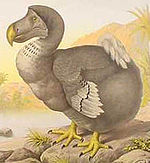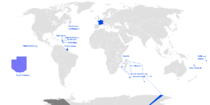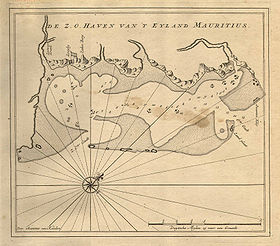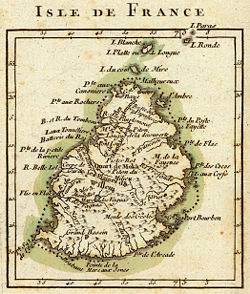- History of Mauritius
-
The known history of Mauritius begins with its discovery by Europeans and its appearance on maps in the early sixteenth century. Mauritius was successively colonized by the Dutch, the French and the British, and became independent in 1968.
Contents
Discovery
It has been frequently hypothesized that Mauritius was first discovered by the Arabs, who named the island Dina Harobi. The first historical evidence of the existence of an island now known as Mauritius is on a map produced by the Italian cartographer Alberto Cantino in 1502.[1] Cantino shows three islands which are thought to represent the Mascarenes (Reunion, Mauritius and Rodrigues) and calls them Dina Margabin, Dina Harobi and Dina Morare. What is known is that the medieval Arab world called the Indian Ocean island region Waqwaq[citation needed].
Portuguese sailors (1507–1513)
Mauritius was discovered and visited by the Portuguese between 1507 and 1513.
An official world map by Diogo Ribeiro described “from west to east, the first island, ‘’Mascarenhas’’, the second, ‘’Santa Apolonia’’ and the third, ‘’Domingo Froiz’’.[2] The three islands (Réunion, Mauritius and Rodrigues) were discovered some years earlier by chance during an exploratory expedition of the coast of the Gulf of Bengal led by Tristão da Cunha. The expedition ran into a cyclone and was forced to change course. Thus, the ship ‘’Cirne’’ of the captain Diogo Fernandes Pereira, came into view of Réunion island on 9 February 1507. They called the island Santa Apolonia ("Saint Apollonia") in honor of that day’s saint. Mauritius was discovered during the same expedition and received the name of ‘’Cirne’’ and Rodrigues that of ‘’Diogo Fernandes’’.[3] Five years later, the islands were visited by Dom Pedro de Mascarenhas[4] who left the name Mascarene for the whole region. The Portuguese took no interest in these isolated islands. They were already established in Asia in Goa, on the coast of Malabar, on the island of Ceylon (now Sri Lanka) and on the Malaysian coast.
Their main African base was in Mozambique, therefore the Portuguese navigators preferred to use the Mozambique Channel to go to India. The Comoros at the north proved to be a more practical port of call. Thus no permanent colony was established on the island by the Portuguese.
Dutch sailors (1598–1637)
In 1598, a Dutch expedition consisting of eight ships set sail from the port of Texel (Netherlands) under the orders of admirals Jacques Cornelius Van Neck and Wybrandt Van Warwyck towards the Indian subcontinent. The eight ships ran into foul weather after passing the Cape of Good Hope and were separated. Three found their way to the northeast of Madagascar while the remaining five regrouped and sailed in a southeasterly direction. On 17 September, the five ships under the orders of Admiral Van Warwyck came into view of the island. On 20 September, they entered a sheltered bay which they gave the name of "Port de Warwick" (present name is "Grand Port"). They landed and decided to name the island "Prins Maurits van Nassaueiland", after Prince Maurits (Latin version: Mauritius) of the House of Nassau, the stadtholder of Holland, but also after the main vessel of the fleet which was called "Mauritius". From those days, only the name Mauritius has remained. On 2 October, the ships took to the sea again towards Bantam.
From then on, the island’s "Port de Warwick" was used by the Dutch as a stopover after long months at sea. In 1606, two expeditions came for the first time to what would later become Port-Louis in the northwest part of the island. The expedition, consisting of eleven ships and 1,357 men under the orders of Admiral Corneille came into the bay, which they named “Rade des Tortues” (literally meaning Harbor of the Tortoises) because of the great number of terrestrial tortoises they found there.[5]
From that date, Dutch sailors shifted their choice to “Rade des Tortues” as harbor. In 1615, the shipwrecking and death of governor Pieter Both, who was coming back from India with four richly laden ships in the bay, caused the route to be considered as cursed by Dutch sailors and they tried to avoid it as much as possible. In the meantime, the British and the Danes were beginning to make incursions into the Indian Ocean. Those who landed on the island freely cut and took with them the precious heartwood of the ebony trees, then found in profusion all over the island.
Dutch colonization (1638–1710)
Main article: Dutch Mauritius A representation of the extinct dodo bird. Dutch presence on the island largely contributed to the extinction of this endemic bird.
A representation of the extinct dodo bird. Dutch presence on the island largely contributed to the extinction of this endemic bird.
Dutch colonization started in 1638 and ended in 1710, with a brief interruption between 1658 and 1666. Numerous governors were appointed, but continuous hardships such as cyclones, droughts, pest infestations, lack of food and illnesses finally took their toll, and the island was definitively abandoned in 1710.
The island was not permanently inhabited for the forty years after its discovery by the Dutch, but in 1638 Cornelius Gooyer established the first permanent Dutch settlement in Mauritius with a garrison of twenty-five. He thus became the first governor of the island. In 1639, thirty more men came to reinforce the Dutch colony. Gooyer was instructed to develop the commercial potential of the island, but he did nothing of the sort, so he was recalled. His successor was Adriaan van der Stel who began the development in earnest, developing the export of ebony wood. For the purpose, Van der Stel brought 105 Malagasy slaves[6] to the island. Within the first week, about sixty slaves were able to run away into the forests; only about twenty of them were eventually recaptured.
In 1644, the islanders were faced with many months of hardships, due to delayed shipment of supplies, bad harvests and cyclones. During those months, the colonists could only rely on themselves by fishing and hunting. Nonetheless, Van der Stel secured the shipment of 95 more slaves from Madagascar, before being transferred to Ceylon. His replacement was Jacob Van der Meersh. In 1645, the latter brought in 108 more Malagasy slaves. Van der Meersh left Mauritius in September 1648 and was replaced by Reinier Por.
In 1652, more hardships befell the colonists, masters and slaves alike. The population was then about a hundred people. The continuing hardships affected the commercial potential of the island and a pullout was ordered in 1657. On 16 July 1658, almost all the inhabitants left the island, except for a ship’s boy and two slaves who had taken shelter in the forests.[7] Thus the first attempt at colonization by the Dutch ended badly.
In 1664, a second attempt was made, but this one also ended badly as the men chosen for the job abandoned their sick commander, Van Niewland, without proper treatment, and the latter eventually died.
From 1666 to 1669, Dirk Jansz Smient administered the new colony at Grand Port, with the cutting down and export of Ebony trees as the main activity. When Dirk Jansz Smient left, he was replaced by George Frederik Wreeden. The latter died in 1672, drowned with five other colonists during a reconnaissance expedition. His replacement would be Hubert Hugo. The later was a man of vision and wanted to make the island into an agricultural colony. His vision was not shared by his superiors, and eventually he could not fully develop his vision.
Issac Johannes Lamotius became the new governor when Hugo left in 1677. Lamotius governed until 1692, when he was deported to Batavia for judgment for persecuting a colonist whose wife had refused his courtship. Thus in 1692 a new governor, Roelof Deodati, was appointed. Even if he tried to develop the island, Deodati faced many problems, like cyclones, pest infestations, cattle illnesses and droughts. Discouraged, Deodati eventually gave up and his replacement would be Abraham Momber Van de Velde. The latter fared no better and eventually became the last Dutch governor of the island for that period. Thus the Dutch definitely abandoned the island in 1710.
Treatment of slaves
Slaves were not particularly well treated by the colonists and revolts or the act of organizing one was severely repressed and punished. Some punishments consisted of amputation of various parts of the body and exposure in the open air for a day as example to others, eventually culminating in condemned slaves’ execution at sunset.
Legacy of the Dutch
- Providing the name for the country and for many regions over the whole island. Some examples include the "Pieter Both" mountain, the "Vandermeersh" region near Rose-Hill as well as many other names.
- Introduction of sugar cane plants from Java.
- Decimating the local dodo and giant tortoise population for food and by introducing competing species and pests, sometimes involuntarily.
- Clearing of large swaths of forests for Ebony bark exploitation.
French rule (1710–1810)
Abandoned by the Dutch, the island became a French colony when, in September 1715, Guillaume Dufresne d'Arsel landed and took possession of this port of call on the route to India. He named the island "Isle de France", but it was only in 1721 that the French started their occupation. However, it was only from 1735, with the arrival of the French governor, Mahé de La Bourdonnais, that "Isle de France" started developing effectively.
Mahé de La Bourdonnais established Port Louis as a naval base and a shipbuilding centre. Under his governorship, numerous buildings were built, a number of which still stand today: part of Government House, the Chateau de Mon Plaisir at Pamplemousses and the Line Barracks. The island was under the administration of the French East India Company which maintained its presence until 1767.
In 1806 the Governor General, Charles Mathieu Isidore Decaen, created the city of Mahébourg, named in honour of Mahé de La Bourdonnais. It was originally known as Bourg Mahé. From that year until 1810, the island was in charge of officials appointed by the French Government, except for a brief period during the French Revolution, when the inhabitants set up a government virtually independent of France.
During the Napoleonic wars, the "Isle de France" had become a base from which French corsairs organised successful raids on British commercial ships. The raids continued until 1810 when a strong British expedition was sent to capture the island. A preliminary attack was foiled at Grand Port in August 1810, but the main attack launched in December of the same year from Rodrigues, which had been captured a year earlier, was successful. The British landed in large numbers in the north of the island and rapidly overpowered the French, who capitulated. By the Treaty of Paris in 1814, the "Isle de France" which was renamed Mauritius was ceded to Great Britain, together with Rodrigues and the Seychelles. In the act of capitulation, the British guaranteed that they would respect the language, the customs, the laws and the traditions of the inhabitants.
British rule (1810–1968)
See also Governor of Mauritius.
Despite the only French naval victory (during the Napoleonic Wars) of Battle of Grand Port on 19 and 20 August 1810 by a fleet commanded by Pierre Bouvet, Mauritius was captured on 3 December 1810 by the British under Commodore Josias Rowley. Their possession of the island was confirmed four years later by the Treaty of Paris (1814). French institutions, including the Napoleonic code of law, were maintained. The French language was at that moment still used more widely than English.
The British administration, which began with Robert Townsend Farquhar as governor, was followed by rapid social and economic changes. One of the most important events was the abolition of slavery on the first of February 1835. The planters received a compensation of two million pounds sterling for the loss of their slaves which had been imported from Africa and Madagascar during the French occupation.
Mauritian Creoles trace their origins to the plantation owners and slaves who were brought to work the sugar fields. Indo-Mauritians are descended from Indian immigrants who arrived in the 19th century via the Aapravasi Ghat in order to work as indentured laborers after slavery was abolished in 1835. Included in the Indo-Mauritian community are Muslims (about 17% of the population) from the Indian subcontinent. The Franco-Mauritian elite controls nearly all of the large sugar estates and is active in business and banking. As the Indian population became numerically dominant and the voting franchise was extended, political power shifted from the Franco-Mauritians and their Creole allies to the Indo-Mauritians.
Sir George Ferguson Bowen was governor from 1879 to 1883.
Conflicts arose between the Indian community (mostly sugarcane labourers) and the Franco-Mauritians in the 1920s, leading to several – mainly Indian – deaths. Following this the Mauritius Labour Party was founded in 1936 by Maurice Cure to safeguard the interest of the labourers. Cure was succeeded a year later by Emmanuel Anquetil who tried to gain the support of the port workers. After his death, Guy Rozemond took over the leadership of the party.
Indentured labour
When slavery was abolished on February 1, 1835, an attempt was made to secure a cheap source of adaptable labour for intensive sugar plantations in Mauritius. Indentured labour began with Chinese, Malay, African and Malagasy labourers, but ultimately, it was India which supplied the much needed laborers to Mauritius. This period of intensive use of Indian labour took place during British rule, with many brutal episodes and a long struggle by the indentured for respect. The term applied to the indentured during this period, and which has since become a derogatory term for Mauritians of Asian descent, was Coolie. The island soon became the key-point in the trade of indentured laborers, as thousands of Indians set forth from Calcutta or Karikal; not only did they modify the social, political and economic physiognomies of the island, but some also went farther, to the West Indies.
The meeting of a mosaic of people from India, China, Africa and Europe began a process of hybridisation and intercultural frictions and dialogues, which poet Khal Torabully has termed "coolitude".[8] This social reality is a major reference for identity opened to otherness and is widely used in Mauritius where it represents a humanism of diversity.
Towards independence
Elections in 1947 for the newly created Legislative Assembly marked Mauritius's first steps toward self-rule, and were won by the Labour Party, headed by Guy Rozemont. It was the first time the elite Francophones were ousted from power. An independence campaign gained momentum after 1961, when the British agreed to permit additional self-government and eventual independence. A coalition composed of the Mauritian Labour Party (MLP), the Muslim Committee of Action (CAM) of Sir Abdool Razack Mohamed, and the Independent Forward Bloc (IFB) – a traditionalist Hindu party – won a majority in the 1967 Legislative Assembly election, despite opposition from Franco-Mauritian and Creole supporters of Gaetan Duval's and Jules Koenig's Mauritian Social Democratic Party (PMSD). The contest was interpreted locally as a referendum on independence. The election was won by a small margin. Constituency No. 15 was key to the victory by the pro-independence coalition. The MLP led alliance was able to win this constituency only due to the support of the CAM. Sir Seewoosagur Ramgoolam, MLP leader and chief minister in the colonial government, became the first prime minister after independence, on 12 March 1968. This event was preceded by a period of communal strife, brought under control with assistance from British troops. The communal strife that preceded independence led to around 300 deaths [1].
Independence
Mauritius became an independent state on March 12, 1968, with the British monarch, Elizabeth II, represented as head of state the Governor-General. The last Governor, Sir John Shaw Rennie served as the first Governor-General until August 27 1968.
1969 saw the emergence of the Mouvement Militant Mauricien led by Paul Bérenger. The MMM was founded in 1969 and had for President and secretary, Heeralall Bhugaloo and Paul Bérenger respectively. The MMM won its first election in a by election of constituency No. 5 by electing Dev Virasawmy. Until 1982, Sir Seewoosagur was Prime Minister, his Labour Party in coalition with Duval's PMSD. In 1982, the coalition of Mouvement Militant Mauricien/Parti Socialiste Mauricien came to power in a landslide electoral victory, with Sir Anerood Jugnauth as Prime Minister and Harish Boodhoo as the deputy Prime Minister. The coalition split in 1983, with Anerood Jugnauth forming the Mouvement Socialiste Mauricien (MSM), which became the governing party, with Jugnauth as Prime Minister. Sir Seewoosagur subsequently became Governor-General.
After Sir Seewoosagur's death, first Sir Satcam Boolell, then Sir Seewoosagur's son, Navin Ramgoolam succeeded him as leaders of the MLP. However, the MLP and PMSD were defeated at the 1991 election, which saw Sir Anerood Jugnauth re-elected under a MMM/MSM government.
In December 1991, the Constitution was amended to make Mauritius a republic within the Commonwealth. Mauritius became a republic on March 12 1992, with the last Governor General, Sir Veerasamy Ringadoo, as interim President. He was succeeded by Cassam Uteem on June 30, 1992.
Navin Ramgoolam led a MLP-MMM coalition to victory at the 1995 general elections, replacing Sir Aneerood Jugnauth as Prime Minister, a post the latter had occupied for 13 years. The governing coalition split in 1997, with the MMM going back to the Opposition and Navin Ramgoolam staying on as Prime Minister.
Present day
At the next elections in 2000, Sir Anerood Jugnauth’s MSM, in coalition with Paul Bérenger’s MMM was returned to power, with Sir Anerood Jugnauth appointed as Prime Minister. He subsequently retired as Prime Minister after 3 years and assumed the office of President. For the remaining time of the elected government the Prime Minister’s post was filled by Paul Bérenger. At the 2005 general elections, the MLP led Alliance Sociale coalition won the elections and Navin Ramgoolam became Prime Minister while Sir Anerood Jugnauth remained the president. The 2010 general elections saw the victory of a MLP-MSM-PMSD coalition (known as "L'Alliance de l'Avenir") and the maintaining of Navin Ramgoolam as Prime Minister.
See also
- History of Africa
- History of Southern Africa
- Politics of Mauritius
- List of Prime Ministers of Mauritius
Notes and references
- ^ Toorawa, S. 2007. The medieval Waqwaq islands and the Mascarenes. Hassam Toorawa Trust, Port Louis, Mauritius
- ^ Albert Pitot, T’Eyland Mauritius, Esquisses Historiques (1598–1710) 1905, p. 4.
- ^ Jacques Auber, Histoire de l’océan Indien, 1955, p. 233
- ^ Auguste Toussaint attributes the discovery of Mauritius to Mascarenhas whereas Albert Pitot hesitates to do so. André de Chapuiset Le Merle in his “Précis d’histoire de l’île Maurice”, 1948, states that it is really Pedro de Mascarenhas and not Pedro Mascarenhas, who went to India only in 1554.
- ^ Auguste Toussaint, Histoire des îles Mascareignes, p. 24
- ^ Dr A. Satteeanund Peerthum, Resistance Against Slavery, 1989, in Slavery in the South West Indian Ocean, MGI, p. 25
- ^ Albert Pitot, T’Eyland Mauritius, Esquisses Historiques (1598–1710) 1905, p. 116
- ^ Khal Torabully, Coolitude : An Anthology of the Indian Labour Diaspora (with Marina Carter, Anthem Press, London, 2002) ISBN 1843310031
External links
- The Mauritius Museums Council, a body corporate under the aegis of the Ministry of Arts and Culture
- History of Mauritius island
- WorldStatesmen- Mauritius
- History of Mauritius in the French period
- History of Mauritius
Links to related articles  Mauritius topics
Mauritius topicsDistricts Black River · Flacq · Grand Port · Moka · Pamplemousses · Plaines Wilhems · Port Louis · Rivière du Rempart · Savanne
Dependencies and
territoriesTerritorial claims Politics and
governmentEconomy People Religion Culture Other topics History of Africa Sovereign
states- Algeria
- Angola
- Benin
- Botswana
- Burkina Faso
- Burundi
- Cameroon
- Cape Verde
- Central African Republic
- Chad
- Comoros
- Democratic Republic of the Congo
- Republic of the Congo
- Côte d'Ivoire (Ivory Coast)
- Djibouti
- Egypt
- Equatorial Guinea
- Eritrea
- Ethiopia
- Gabon
- The Gambia
- Ghana
- Guinea
- Guinea-Bissau
- Kenya
- Lesotho
- Liberia
- Libya
- Madagascar
- Malawi
- Mali
- Mauritania
- Mauritius
- Morocco
- Mozambique
- Namibia
- Niger
- Nigeria
- Rwanda
- São Tomé and Príncipe
- Senegal
- Seychelles
- Sierra Leone
- Somalia
- South Africa
- South Sudan
- Sudan
- Swaziland
- Tanzania
- Togo
- Tunisia
- Uganda
- Zambia
- Zimbabwe
States with limited
recognition- Sahrawi Arab Democratic Republic
- Somaliland
Dependencies and
other territories- Canary Islands / Ceuta / Melilla / Plazas de soberanía (Spain)
- Madeira (Portugal)
- Mayotte / Réunion (France)
- Saint Helena / Ascension Island / Tristan da Cunha (United Kingdom)
- Western Sahara
Dutch Empire Colonies and trading posts of the Dutch East India Company (1602-1798) GovernoratesAmbon · Banda · Batavia · Cape Colony · Ceylon · Coromandel · Formosa · Northeast coast of Java · Makassar · Malacca · MoluccasDirectoratesCommandmentsResidenciesSettlements with an opperhoofdColonies and trading posts of the Dutch West India Company (1621-1792) Colonies in the AmericasAcadia · Berbice† · Cayenne · Curaçao and Dependencies · Demerara · Essequibo · Brazil · New Netherland · Pomeroon · Sint Eustatius and Dependencies · Suriname‡ · Tobago · Virgin IslandsTrading posts in Africa† Governed by the Society of Berbice · ‡ Governed by the Society of SurinameSettlements of the Noordsche Compagnie (1614-1642) SettlementsColonies of the Kingdom of the Netherlands (1815-1962) Until 1825Until 1853Until 1872Until 1945Until 1954Until 1962† Became constituent countries of the Kingdom of the Netherlands; Suriname gained full independence in 1975, Curaçao and Dependencies was renamed to the Netherlands Antilles, which was eventually dissolved in 2010.Kingdom of the Netherlands (1954-Present) Constituent countriesPublic bodies of the NetherlandsFrench overseas empire Former Former French colonies in Africa and the Indian Ocean Maghreb - Algeria
- Morocco (Arguin Island)
- Tunisia
French West Africa French Equatorial Africa Comoros - French Somaliland (Djibouti)
- Madagascar
- Ile de France
- Seychelles
Former French colonies in the Americas Inini · Berbice · Saint-Domingue (Haiti) · Tobago · Virgin Islands · France Antarctique · Equinoctial FranceFormer French colonies in Asia and Oceania French India Indochinese Union French Mandate for Syria and the Lebanon Oceania France-Asia relations · French East India CompanyPresent  Overseas departments and territories of France
Overseas departments and territories of FranceInhabited areas  Special status
Special statusUninhabited areas Pacific Ocean French Southern and
Antarctic LandsBanc du Geyser4 · Bassas da India4 · Europa Island4 · Glorioso Islands3, 4, 5 · Juan de Nova Island4 · Tromelin Island4, 51 Also known as overseas regions. 2 Claimed by Comoros. 3 Claimed by Madagascar. 4 Claimed by Seychelles. 5 Claimed by Mauritius.Categories:
Wikimedia Foundation. 2010.


